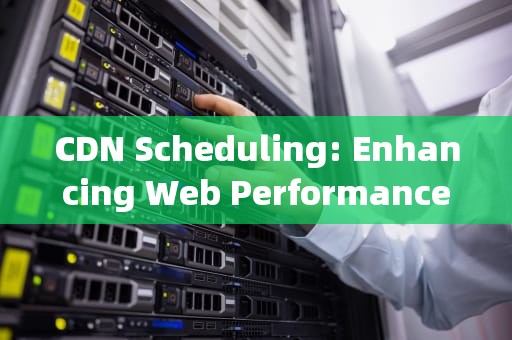Content Delivery Network (CDN) is a technology that has dramatically transformed the way we access and distribute web content. By leveraging a network of geographically distributed servers, CDNs ensure that users receive data from the closest possible server, reducing latency, improving load times, and enhancing overall user experience. In this article, we will explore the intricacies of CDN scheduling, its importance, and how it impacts various aspects of web performance and reliability.

What is CDN Scheduling?
CDN scheduling involves the strategic distribution and management of content across multiple servers to optimize content delivery based on factors such as user location, server load, and network conditions. The primary goal is to ensure that each user request is routed to the most appropriate server, thereby minimizing delay and maximizing throughput.
Importance of CDN Scheduling
1、Enhanced User Experience: By delivering content from the nearest server, CDN scheduling reduces the physical distance data must travel, resulting in faster load times and smoother browsing experiences. This is particularly crucial for latency-sensitive applications like online gaming, video streaming, and real-time voice/video communications.
2、Improved System Reliability: CDNs distribute content across multiple servers, which means that if one server fails or becomes overwhelmed, others can take over, ensuring continuous service availability. This redundancy is vital for maintaining high uptime and reliability.
3、Scalability: CDN scheduling allows websites to easily scale their operations to accommodate traffic spikes without compromising performance. During events like major sales or viral content releases, CDNs can dynamically allocate resources to handle increased demand efficiently.
4、Cost Efficiency: By optimizing content delivery and reducing the need for excessive bandwidth and infrastructure investments, CDNs help organizations save money. Additionally, many CDN providers offer pay-as-you-go models, allowing businesses to pay only for the resources they actually use.
How CDN Scheduling Works
1、DNS-Based Dispatching: When a user requests a webpage, the Domain Name System (DNS) resolver directs the request to the nearest CDN edge server based on IP geolocation data. This ensures that the user is connected to the most efficient server for their location.
2、Load Balancing: Advanced algorithms distribute incoming requests across multiple servers to prevent any single server from becoming a bottleneck. Common load balancing methods include round-robin, least connections, and IP hash techniques.
3、Content Caching: CDNs cache static and dynamic content at edge servers. When a user requests content, the CDN delivers it from the nearest cache, reducing the need to fetch the content from the origin server and decreasing response times.
4、Real-Time Optimization: CDNs continuously monitor network conditions and server loads, adjusting the distribution and routing of content on the fly to ensure optimal performance. This might involve shifting traffic away from congested areas or re-routing requests to healthier servers during failures.
Types of CDN Scheduling
1、Global Server Load Balancing (GSLB): Distributes traffic across regional data centers to ensure that users are directed to the optimal server within a certain geographic region.
2、Geographical Routing: Uses geo-IP mapping to direct users to the nearest server based on their geographic location, thus minimizing latency.
3、Latency-Based Routing: Prioritizes servers with the lowest network latency, ensuring quick data delivery regardless of geographical proximity.
4、Hybrid Scheduling: Combines multiple scheduling strategies to balance factors like latency, server load, and geographic location dynamically.
Challenges in CDN Scheduling
1、Synchronization: Keeping content synchronized across all edge servers can be challenging, especially for dynamic content that changes frequently.
2、Consistency: Ensuring that users always receive consistent content, even when servers have slight delays in updating can be complex.
3、Security: Protecting against attacks like DDoS while maintaining efficient content delivery requires robust security measures and intelligent threat detection.
4、Configuration: Properly configuring CDN schedulers to meet specific business needs requires careful planning and ongoing management.
Best Practices for CDN Scheduling
1、Select the Right CDN Provider: Choose a provider that offers robust scheduling capabilities, advanced caching mechanisms, and global coverage tailored to your target audience.
2、Regularly Update Content: Ensure that your CDN is configured to update cached content at appropriate intervals to keep information fresh and relevant.
3、Monitor Performance: Continuously monitor CDN performance using analytics tools to identify bottlenecks and optimize scheduling strategies.
4、Implement Redundancy: Design your CDN architecture with redundancy in mind to handle server failures and maintain uninterrupted service.
5、Security Measures: Employ security features such as token authentication, SSL/TLS encryption, and Web Application Firewalls (WAF) to protect against common cyber threats.
6、Dynamic Content Handling: Leverage technologies like edge computing and smart routing to efficiently manage dynamic content delivery and reduce latency.
Future Trends in CDN Scheduling
1、Artificial Intelligence and Machine Learning: AI and ML are increasingly being used to predict traffic patterns and optimize CDN scheduling dynamically, offering smarter and more efficient content distribution.
2、Edge Computing: As IoT and real-time processing needs grow, edge computing will play a critical role in bringing computation closer to the data source, reducing latency even further.
3、5G Integration: The rollout of 5G networks promises to enhance mobile connectivity, offering higher speeds and lower latency, making CDN scheduling even more effective.
4、Personalized Content Delivery: Advances in big data and analytics will enable CDNs to deliver highly personalized content based on individual user preferences and behavior patterns.
In conclusion, CDN scheduling is an indispensable component of modern web infrastructure, providing significant benefits in terms of performance, reliability, and cost savings. As technology continues to evolve, we can expect CDN scheduling to become even more sophisticated, further enhancing the way we access and distribute web content.
随着互联网的普及和信息技术的飞速发展台湾vps云服务器邮件,电子邮件已经成为企业和个人日常沟通的重要工具。然而,传统的邮件服务在安全性、稳定性和可扩展性方面存在一定的局限性。为台湾vps云服务器邮件了满足用户对高效、安全、稳定的邮件服务的需求,台湾VPS云服务器邮件服务应运而生。本文将对台湾VPS云服务器邮件服务进行详细介绍,分析其优势和应用案例,并为用户提供如何选择合适的台湾VPS云服务器邮件服务的参考建议。

工作时间:8:00-18:00
电子邮件
1968656499@qq.com
扫码二维码
获取最新动态
